
|
Wolverhampton's Blue Plaques
Lichfield Street,
Fryer Street, Wulfruna Street & Victoria Square |
 |
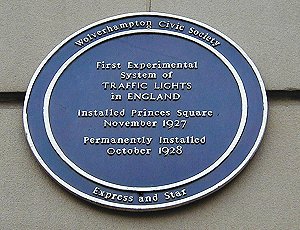 |
Commemorating: The first traffic lights in
England.
Sponsored by:
The Express & Star
Location:
Princes Square, on the front of Rothwells. |
| The traffic lights were originally located on a small
island in the middle of Princes Square. They were installed initially as
an experiment on 5th November 1927. The experiment was presumably a
success, as the lights became a permanent installation in October of the
following year, and are still here today. |
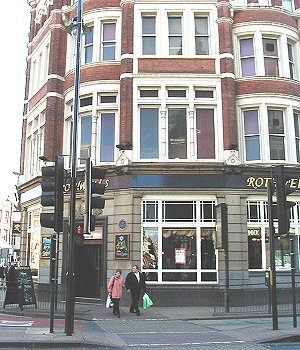 |
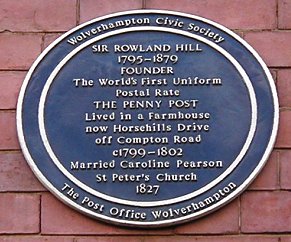 |
Commemorating: Sir Roland Hill who founded the
penny post.
Sponsored by:
The Post Office.
Location:
Lichfield Street, on the front of the old post
office.
|
| Sir Roland Hill was born at 96 Blackwell Street,
Kidderminster, on 3rd December 1795. The family soon moved to Horsehills
Farm, Wolverhampton, which was on the corner of Compton Road and
Richmond Road. The family who were quite poor, lived there for four
years before moving to Birmingham. Roland met his future wife there at
the age of six, and married her in St John's Church on 27th September
1827. Her name was Caroline Pearson, whose father Joseph Pearson was a
local manufacturer and County Magistrate. They lived at Graiseley House,
off the Penn Road. |
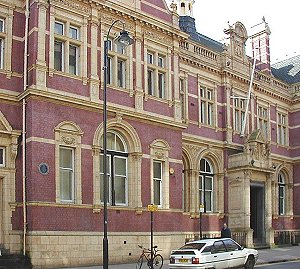 |
Roland and Caroline where part-owners of
White Lodge, which was next door to Graiseley House. They moved to London,
where Roland was a schoolmaster, but at the age of 38 he became secretary of
the South Australia Commission, an association which helped with the
colonisation of the country. He became interested in postal reform and
produced a pamphlet on the subject. He proposed that letters should be
charged by weight, not distance and that the sender should pay the postage.
The scheme went before Parliament in 1837 and an Act of Parliament gave the
Royal Assent in 1839. From January 10th, 1840, a letter not exceeding half
an ounce could be sent to any part of the country for one penny. Roland was
given a two year post in the Treasury to help with the introduction of the
new postal service. The famous Penny Black stamp soon had to be changed to
the Penny Red because of forgeries. Roland lost his job in 1842 after the
change of Government and joined the London and Brighton Railway Company.
After the next change of Government he was given the job of
Secretary to the Post Master General in 1854. At the age of 59 he was
offered the post of secretary to the Post Office, a position he held until
his retirement in 1864. During this time he introduced money orders,
travelling post offices, the Post Office Savings Bank and improved rural
services. On his retirement he was awarded his full salary as a pension for
life and given a special parliamentary grant of £20,000. He was knighted in
1860 and was granted the freedom of London in 1879. A few months later he
died at the age of 84 and was buried in Westminster Abbey. Roland and
Caroline had one son and three daughters.
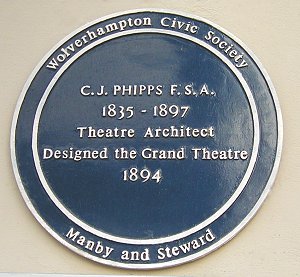 |
Commemorating: C. J. Phipps, theatre
architect.
Sponsored by:
Manby & Steward, solicitors.
Location:
On the front of the Grand Theatre, Lichfield
Street.
|
| C. J. Phipps, an experienced theatre architect designed
the Grand Theatre in the early 1890's. The foundation stone was laid on
28th June, 1894 by Mrs. C. T. Mander, who at the time was Lady Mayoress.
The theatre was built by Henry Gough and cost £10,000. It opened on 10th
December 1894. The first performance was Gilbert & Sullivan's opera
'Utopia Limited'. It was performed by Mr. R. D'Oyly Carte's company and
all of the 2,151 seats were taken. |
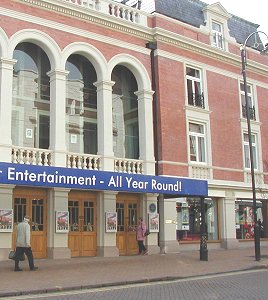 |
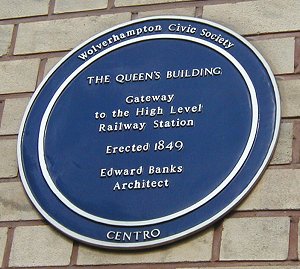 |
Commemorating:
The Queen's Building. Sponsored by:
Centro.
Location:
On the front of the Queen's Building in Victoria Square.

|
| The building was designed by
Edward Banks who was architect for the Shrewsbury & Birmingham Railway
Company. It was used as a grand entrance building for the railway
station, company offices and boardroom. It had four arches, the centre
two were for carriages, and the outer two for pedestrians. Above the
entrance were the offices and boardroom for the railway company, and at
each side was a row of shops. The building opened on 10th October 1849.
The station was originally known as Wolverhampton General station, but
renamed Queen Street station in September 1853, because the entrance
building faced Queen Street. |
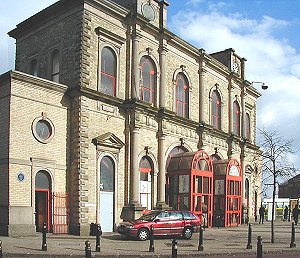 |
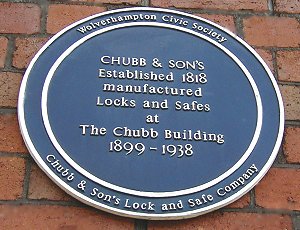 |
Commemorating: Chubb & Son's, lock and safe
manufacturers.
Sponsored by:
Chubb & Son's Lock & Safe Company.
Location:
On the front of the Chubb Building in Fryer
Street. |
| The Chubb brothers, Charles & Jeremiah, served their
apprenticeships to a blacksmuith in Winchester. In 1804 they moved to
Portsmouth where Charles opened a shop specialising in naval
ironmongery. In 1818 the brothers took out their fist patent for the
Detector lock and started to manufacture locks. They moved to
Wolverhampton and opened a factory in Temple Street. They began
manufacturing safes in the early 1830's and took out a patent for a
burglar resisting safe in 1835. Charles died in 1846 and the business
was taken over by his son John. Towards the end of the century a larger
factory was required and so the Chubb Building was built and opened in
1899. |
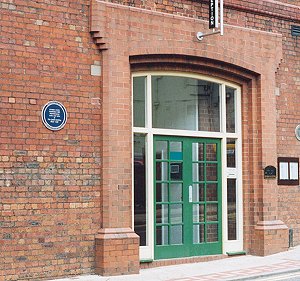 |
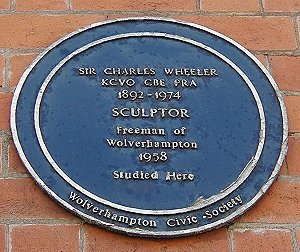 |
Commemorating: Sir Charles Wheeler, sculptor.
Sponsored by:
Wolverhampton Civic Society.
Location:
On the rear of the Art Gallery Annex in
Wulfruna Street..
|
| Sir Charles Wheeler (1892-1974)
was the first sculptor to be elected President of the Royal
Academy of Arts. He was born in 1892 at Codsall, and studied at the
Wolverhampton School of Art under Robert Emerson. He later studied at
the Royal College of Art. Examples of his work can he seen on many
London buildings including the Bank of England, India House and South
Africa House. He also sculpted the statue of Lady Wulfruna which stands
outside St. Peter's Church in Wolverhampton. The Art Gallery Annex
opened in 1887 and was originally the offices of the Wolverhampton Board
of Guardians. |
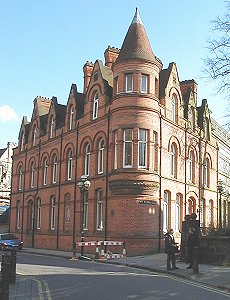 |
 |
Commemorating: William Wood, Ironmaster.
Sponsored by:
The Polytechnic Wolverhampton.
Location:
On the front of the University in Wulfruna
Street.
|
| William Wood was born on 31st July 1671. He became an
ironmaster and owned several copper and iron works in the west of
England.
He also had the lease for a number of mines that were on Crown
property. He lived in the Deanery from 1692 to 1713, where he laid out a
walled fruit garden.
He supplied coinage to America and Ireland where he
was perceived as an example of British imperialism.
His effigy was
hanged in the streets of Dublin. He died in London and was buried in
Wolverhampton on 6th August 1730. |
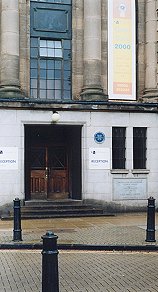 |
|
















